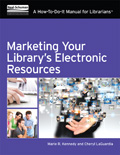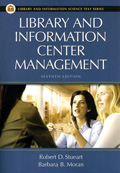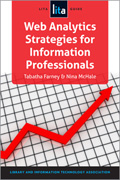
Popular wisdom says if you want to learn how to use your latest piece of consumer technology, you find an 8-year-old to teach you. In “The Children of Cyberspace: Old Fogies by Their 20s,” (The New York Times, Jan. 9, 2010), Brad Stone looked at how children view technology differently than adults, and even how children just a few years apart in age view technology differently than each other. What this means for libraries, of course, is that besides being able to keep track of the latest in readers’ advisory, cataloging rules, or the financial policies of our governing bodies, we must also be able to work with library users wherever they are on the technology continuum, from total novice to tech-savvy 8-year-old. In this issue, we look at recent titles that help us stay up to date with both technology and library services.
 The New Digital Scholar: Exploring and Enriching the Research and Writing Practices of NextGen Students, edited by Randall McClure and James P. Purdy, tackles the question of how to teach information literacy skills to digital natives—those who have always lived in an internet age but need to learn how to locate in-depth information and how to capture and integrate it for effective research writing. The essayists cover aspects of the challenge, analyzing what NextGen students know or don’t know and reviewing possible ways to teach concepts and skills. They also look at research on the ways academic libraries can transform their digital interfaces to enhance student learning.
The New Digital Scholar: Exploring and Enriching the Research and Writing Practices of NextGen Students, edited by Randall McClure and James P. Purdy, tackles the question of how to teach information literacy skills to digital natives—those who have always lived in an internet age but need to learn how to locate in-depth information and how to capture and integrate it for effective research writing. The essayists cover aspects of the challenge, analyzing what NextGen students know or don’t know and reviewing possible ways to teach concepts and skills. They also look at research on the ways academic libraries can transform their digital interfaces to enhance student learning.
Indexed. Information Today for the American Society for Information Science and Technology. 416 p. $59.50. 978-1-57387-475-5 (Also available as an ebook.)
 Just as the rules for accessing information are changing, so too are the copyright rules for using that information in print, courseware, web-based delivery, and archives. Although copyright isn’t a new technology, new technology has the ability to complicate our understanding of copyright. Laura N. Gasaway, who has written and spoken about the issue for decades, has collected updated versions of columns she published during a 15-year period in Copyright Questions and Answers for Information Professionals: From the Columns of Against the Grain. Using real questions submitted to her through the years, Gasaway has grouped by topic issues such as permissions, digitization, and library reserves. The topical arrangement allows for pursuing a subject in detail, but the extensive index enables zeroing in on a detail. A table in the appendix shows when US works pass into the public domain.
Just as the rules for accessing information are changing, so too are the copyright rules for using that information in print, courseware, web-based delivery, and archives. Although copyright isn’t a new technology, new technology has the ability to complicate our understanding of copyright. Laura N. Gasaway, who has written and spoken about the issue for decades, has collected updated versions of columns she published during a 15-year period in Copyright Questions and Answers for Information Professionals: From the Columns of Against the Grain. Using real questions submitted to her through the years, Gasaway has grouped by topic issues such as permissions, digitization, and library reserves. The topical arrangement allows for pursuing a subject in detail, but the extensive index enables zeroing in on a detail. A table in the appendix shows when US works pass into the public domain.
Indexed. Purdue University Press. 228 p. PBK. $24.95. 978-1-55753-639-6 (Also available as an ebook.)
 Electronic resources are critical components in a library’s ability to deliver in-depth, targeted content to users. But marketing is vital if the resources will be used to their fullest. Marketing Your Library’s Electronic Resources: A How-to-Do-It Manual for Librarians by Marie R. Kennedy and Cheryl LaGuardia offers an overview, practical suggestions, bibliographies for further reading, worksheets, and sample plans. The authors, both academic librarians, go through the steps of determining the purpose of the marketing plan, its development and implementation, and finally its evaluation and possible refinement and relaunch.
Electronic resources are critical components in a library’s ability to deliver in-depth, targeted content to users. But marketing is vital if the resources will be used to their fullest. Marketing Your Library’s Electronic Resources: A How-to-Do-It Manual for Librarians by Marie R. Kennedy and Cheryl LaGuardia offers an overview, practical suggestions, bibliographies for further reading, worksheets, and sample plans. The authors, both academic librarians, go through the steps of determining the purpose of the marketing plan, its development and implementation, and finally its evaluation and possible refinement and relaunch.
Indexed. Neal-Schuman. 200 p. PBK. $60. 978-1-55570-889-4
 Now in its eighth edition, Library and Information Center Management, edited by Barbara B. Moran, Robert D. Stueart, and Claudia J. Morner, is a textbook, but it is also a resource for the new manager, the experienced manager facing a new problem, or the manager just feeling stale and needing a fresh perspective. The editors, all seasoned managers, present issues and answers to library management concerns in the areas of planning, organizing, human resources, leading, assessment, and fiscal issues. They begin by stating the importance of excellent management, offer a general overview of principles and history of management, and move into issues of change and strategic planning. Each chapter has its own bibliography for in-depth follow-up.
Now in its eighth edition, Library and Information Center Management, edited by Barbara B. Moran, Robert D. Stueart, and Claudia J. Morner, is a textbook, but it is also a resource for the new manager, the experienced manager facing a new problem, or the manager just feeling stale and needing a fresh perspective. The editors, all seasoned managers, present issues and answers to library management concerns in the areas of planning, organizing, human resources, leading, assessment, and fiscal issues. They begin by stating the importance of excellent management, offer a general overview of principles and history of management, and move into issues of change and strategic planning. Each chapter has its own bibliography for in-depth follow-up.
Indexed. Libraries Unlimited. 489 p. PBK. $55. 978-1-59884-989-9
 A key part of strategic planning is having the information about how your library is used. We’re accustomed to door counts and circulation statistics, but what about web usage? Or click-throughs to your electronic resources? Tabatha Farney and Nina McHale address these points and more in Web Analytics Strategies for Information Professionals, a LITA Guide. After an introduction to what kinds of web behavior can be analyzed and how, the authors review how to use the results to make decisions and communicate the findings to those who need to know. The case studies and details on 14 of the currently available analytics tools add a practical component.
A key part of strategic planning is having the information about how your library is used. We’re accustomed to door counts and circulation statistics, but what about web usage? Or click-throughs to your electronic resources? Tabatha Farney and Nina McHale address these points and more in Web Analytics Strategies for Information Professionals, a LITA Guide. After an introduction to what kinds of web behavior can be analyzed and how, the authors review how to use the results to make decisions and communicate the findings to those who need to know. The case studies and details on 14 of the currently available analytics tools add a practical component.
Indexed. ALA Techsource. 232 p. PBK. $70. 978-1-55570-897-9
KAREN MULLER is librarian and knowledge management specialist for the ALA Library.


